The Present

The pursuit of wild edibles has become a popular pastime in these days of organic gardening and macrobiotic menu planning. In our grandfathers’ day here in Philadelphia, gathering dandelion, mustard and other wild greens was a favored activity for an outing. Only recently have we begun again to show much interest in the skills of identifying edible wild plants and medicinal herbs.
In Greece wild plants are highly valued for their medicinal qualities as well as for their tangy, bitter flavor. Wild plants are often considered to be cleaner and purer than cultivated plants, particularly if the latter have been grown with the use of chemical fertilizers. People often say that eating hurt (wild greens] aids digestion, and cleans the blood and the rest of the body. In the open street markets of Athens, one can always find a poor old widow, dressed in black, selling the wild greens of the season.

In urban Greece, gathering wild greens and herbs has long been a popular pursuit for a Sunday excursion into the country or as an important part of a visit to village relatives. A cartoon in a popular Greek magazine shows a housewife from the city intently inspecting the ground for wild edibles. She carries her trusty horta knife in hand, ready to cut a tasty rosette of dandelion-like greens to place in her carry-all bag. Her husband, seated at the wheel of a large sedan, a deep frown furrowing his brow, pleads with her, “My little Andonia, don’t you realize that each forkful of the ‘free’ greens that you gather costs me a quarter?” He is referring to the price of gasoline which in Greece costs about $2.40 a gallon for the lowest grade.
The terrace farmers of Methana, in the Argolid, seek out wild foods, not for recreation but as a part of their basic daily living. As with any people who till the soil for their subsistence, the villagers of Methana know the types and uses of the natural vegetation and find it quite easy to combine gathering with agriculture. The terrace farmer often collects greens and bulbs while making sure that the three or four house goats and sheep grazing in the fallow fields do not wander to nibble the fresh, juicy plants of a neighbor’s garden. In the early summer, women often herd their sheep near the sea. While the animals graze on wheat stubble, the shepherdesses pry sea urchins and limpets from the rough rocks on the shoreline and briefly bathe in the sea. On the way back to the village they harvest fresh vegetables grown in the non-irrigated summer gardens. Also combining the activities of the wild and the sown is the tedious but necessary task of weeding the grain crops. This provides fodder for the lactating ewes and larger lambs as well as greens for the family meal, Since a good Christian should do no “work” on Sunday, men often inspect the state of the crops after a large midday meal. Depending on the location of his fields and the time of year, a man is likely to return from his Sunday stroll with a bag of greens, a basket of mushrooms, or numerous dome-shaped limpets and spiny sea urchins.
Wild plants, wherever they are, are usually free for anyone to gather so long as no damage is done to the crops growing in the fields. Similarly, the products of the sea and the sea’s edge are free to all, Both men and women gather the whole range of wild plants and shoreline marine foods. Women usually do more of the gathering than men because men are expected to do more of the heavier agricultural tasks. Women are more often referred to as the authorities on the edibility of wild plants as well as the proper name for each useful wild plant. Men and younger women do the greater part of the marine gathering because this involves a coordination of farming and household tasks with the long, steep walk to the sea and because marine gathering frequently involves going into the sea to reach the limpets and urchins. The younger women, whose task is tending the sheep, have more flexibility in their activities, allowing them time for marine gathering. Men fish and gather shellfish during the slack periods of the agricultural cycle, while the women pursue domestic activities such as weaving and preparing sun-dried foods for winter.

Children learn to identify wild horta or wild edible plants at an early age. A small girl of age five or six may play the hortn hunting game. She seeks out an armful of what she thinks to be wild edible plants, carries them to her mother for identification of those plants that can be eaten by people and those that are only fit for sheep and goats. She then carefully cleans the greens, mimicking the actions of her mother preparing the family meal. She lays a tiny fire of twigs, drags out a discarded, battered old pot with a hole in the bottom, and places her “clean” greens in the pot and “cooks” them over an imaginary fire. In a few years she will help her mother contribute to the real pot of greens that feeds the family.
Though many people in the city and in the countryside collect wild greens for the family dinner table, the collection and sale of wild greens is widely viewed as the vocation of poor people who have no land to sow. It is for this reason that one often finds old widows selling greens in the streets of Athens.
Leafy, green, wild vegetables are probably the most important wild resources supplementing the diet of the Methana cultivator. Dandelions, chicory, mustard, poppy (leaves only], black nightshade and amaran thus are commonly collected. Leaves, stems and shoots, and some bulbous roots are gathered and eaten, Black bryony shoots, resembling asparagus, are eaten in the early spring, The bulb of the grape hyacinth is a delicacy found on sale in the streets of Athens, as well as in the soot-blackened cooking pots of the village housewife.
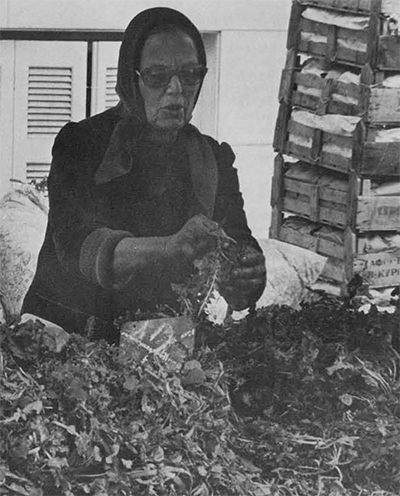
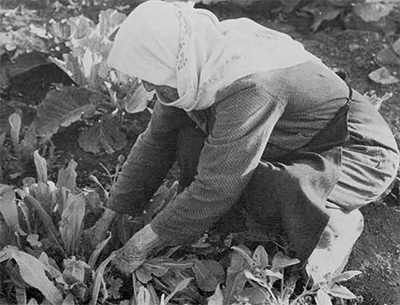
Wild greens are gathered in the unsown fields, in vineyards, and along the edges of planted fields. October through April or May is the main growing season for these wild vegetables as this is the only time of the year when any significant amount of rain falls. The summer dry-gardening techniques conserving water (see the article by Hamish Forbes in this issue which describes the process in detail) also benefit the edible summer crop weeds. Similarly, crop weeds from the grain fields, both edible and non-edible, flourish in the fertilizer and manure spread to improve the growth of domestic plants.
Once gathered, wild greens are always very thoroughly washed. They are most commonly boiled, the cleaned leaves being quickly immersed in a pot of boiling, salted water. After boiling ten to fifteen minutes, the greens and whatever liquid clings to the leaves are served in individual shallow bowls with a generous dash of oil and often a bit of homemade wine vinegar or lemon juice. When the greens have been consumed, the liquid is sopped up with a thick wedge of tasty, heavy, village bread. A mixture of several types of wild greens may be chopped for filling for the special dish of vegetable pie, hortopita. The milder, sweeter greens may be sautéed with olive oil, onions and tomato paste. Certain wild plants, such as the caper, are parboiled, salted and pickled.
Mushrooms are much favored on Methana but people are extremely selective about which mushrooms they will eat, refusing to eat some species that are eaten elsewhere in Greece. Mushrooms grow in the scrublands as well as under olive and other domestic trees. They appear with the winter rains in November or December and disappear with the cold days of midwinter in January. Some types must be pre-boiled and squeezed to remove the bitter juices before they are coated with flour and fried in olive oil. The tastier mushrooms, often only the caps, are roasted in the hot coals or ash of the fire and served with olive oil and a dash of lemon.
Wild fruits such as blackberries, pears, arbutus fruit, and myrtle berries are eaten mainly by children and sheep or goats. These fruits serve as a tasty snack when walking between the village and the fields on other parts of the mountain. Acorns of the valonia oak are gathered for the sheep, goats and the occasional pig. In times of famine they were eaten by humans as well. The valonia acorn does not require any leaching out of poisonous juices as did the acorns eaten by some groups of North American Indians in the past. For human consumption the acorns were toasted in the coals of the fire, just as we toast chestnuts.
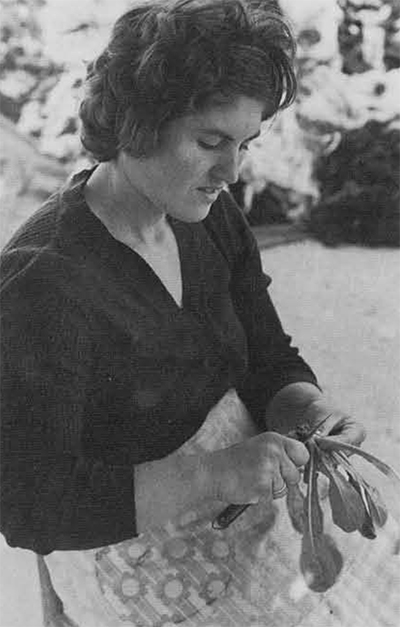
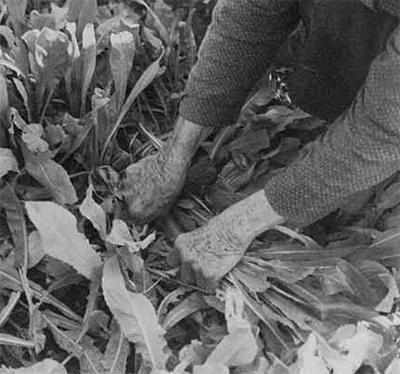
Sea urchins, limpets and periwinkles are pried off the rocks on the shoreline, about forty minutes’ walk below the village. Crabs are occasionally captured in the shallow pools between the shoreline rocks. These marine foods may be eaten raw on the spot or carried back to the village and served raw with bread and a dash of lemon juice. Limpets and periwinkles are occasionally roasted in the coals of the fire. Tiny fish are captured using a casting net thrown onto the water at the shore’s edge.
In the past, some of the men of the village made an overnight journey in a small fishing boat to a nearby uninhabited island to collect land snails. Today the villager goes no farther than the local store to buy snails shipped from Crete where they are collected on a commercial basis.
Herbs, mostly members of the mint family such as marjoram, thyme, sage, and oregano, as well as camomile, are gathered on the hillsides and along the edges of fields. They are tied in bunches and dried in a shaded spot to prevent the sun from bleaching the rich dark green color from the leaves. Herbs are used for seasoning and medicinal tea, camomile and oregano being the most frequently used medicinal herbs. Village herbal medicine is very simple, consisting of teas, poultices and salves for such common ailments as colds, upset stomach, nerves, and insomnia. Camomile is also sometimes administered to a sick sheep or goat.
Some villagers have taken small bushes of choice wild culinary herbs such as rosemary and bay from the mountainside to their house garden in the village. They share this ready supply of tasty herbs with other villagers. Methana’s oregano, wild and strongly flavored, is gathered in large quantities by some village women for sale in the local street market, Some oregano is sold to itinerant merchants who purchase it at a flat rate by weight to be marketed in Athens or used commericaIly for pharmaceuticals. Bunches of Methana oregano are given as gifts to visiting relatives and to strangers in the community such as schoolteachers and anthropologists.
Gathering activities supplement the diet of beast as well as man. Green branches of mountain scrub cover such as arbutus have traditionally been cut, bundled and carried back to the village to feed the livestock, In the past when few fodder crops were sown, these leafy branches were a major part of the food fed to the sheep and goats in addition to the lower herbage that the animals could graze by themselves. When the sheep and goats have stripped the leaves from the bundled branches, the bundles are stacked to dry for firewood to heat the dome-shaped bread ovens built of stone, and for the fireplace that serves both to heat the house and to cook most food.
Vegetables in general play an important role in the rural Greek diet. Nutritional surveys conducted on Mainland Greece and on Crete following World War II, compared with similar surveys conducted in rural America during the same time period, show a much lower intake of animal protein and sugary sweets in the Greek diet. In both the United States and Greece, the rural diet included a greater percentage of vegetable foods than the urban diet, but in Greece the vegetable emphasis is greater. Eating wild greens is a part of this heavy reliance on vegetable foods. They supplement essential vitamins and minerals at times of the year when cultivated crops are limited and at times when the religious fasting rules restrict diet variety.
Wild greens serve as a tasty, nutritious seasoning for rather bland bread combined with locally pressed olive oil. To eat a plain piece of bread is not considered to be a meal by a Methana farmer. To eat cooked wild greens without olive oil is unheard of unless one is devoutly abstaining from oil for a specific religious fast day. The combination of bread, greens and olive oil is regarded as a proper meal. Better yet is the addition of a fried egg or a piece of cheese. Obviously taste preferences here produce a nutritious combination of foods from the basic food groups. Bread protein is complemented by cheese and egg protein which provide the essential amino acids lacking in the bread. The greens add vitamins, minerals and plant protein. The bread and the oil offer energy giving calories and essential fats respectively. In the past when transportation and trade were very limited, this nutritious combination was a major part of the diet for the winter and some summer months. For some of the poorer families in many parts of rural Greece, greens continue to be a mainstay of the diet.
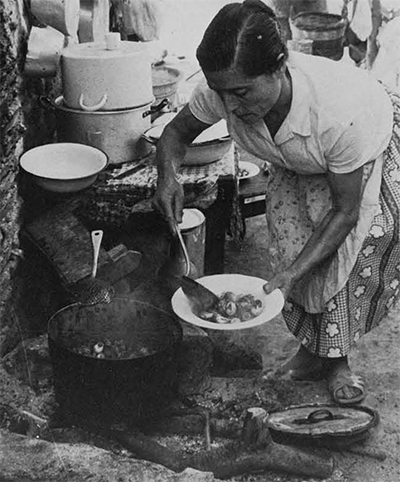
During the long Lenten fast, devout followers of the Greek Orthodox faith abstain from all animal products [red meat, fish, poultry, eggs, and milk products]. Many marine foods such as limpets, sea urchins, octopus, and cuttlefish, as well as land snails, are not classed as “animal” foods and are thus acceptable protein sources during fasting periods. Land snails are sometimes served as a special dish for guests during celebrations that fall within a fasting period.
Marine gathering also aids day-to-day hospitality for male socializing by providing a meze, a savory tidbit to accompany wine drinking. A meze can be simply bread and olives or it may be a store-bought item such as smoked herring, Usually the meze is a salty (thirst-making) food that increases the appetite for more wine. Raw limpets are particularly popular as a meze and yet require no cash outlay on the part of the host.
Wild foods supplement the diet of the Methana terrace farmer in times of feasting, fasting and famine. Wild foods offer favored delicacies as meze treats as well as a plentiful supply of wild greens for dependable family fare in the winter.
The Prehistoric Past
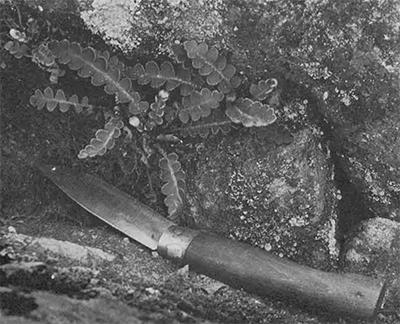
With this picture of the present day pursuit of wild edibles in mind, let us see if we can catch a glimpse of the culinary possibilities available to the earliest farmers in the Argolid. The systematic excavations conducted by Thomas Jacobsen in the Franchthi Cave near the fishing village of Koiladha promise to provide a fairly detailed picture of the economic life of the users of the cave from the Upper Palaeolithic (roughly 20,000 B.C.) through the Late Neolithic (around 3,000 B.C.). Because research is still in progress on the excavated material, we must await final reports on pollen analysis, on other botanical evidence, and on zoological remains before drawing any defi nite conclusions. Nevertheless, on the basis of current knowledge we can suggest what might have been the relationship of the Franchthi people to their environment in terms of the basic need of getting enough to eat. Preliminary analyses of plant and animal remains point to a gradual change in climate from a cold, dry environment in the later Ice Age to a warmer, wetter climate in the following postglacial (Mesolithic and Neolithic) periods (after about 8,000 B.C.), when the environment was closer to that of the present. It is likely that the plants and animals found in the area today could have flourished also in these last two periods.
The abundant shells in the archaeological record for the Mesolithic period, just prior to the first evidence of the use of cultivated plants, appear to be of the same type of snail as that gathered by local people today. Evidence suggests that the sea level was lower in prehistoric times so that portions of Koiladha Bay which the cave overlooks might then have been a marsh. If this was the case, the wildlife and vegetation from these marshes would have provided rich food resources for the earlier Franchthi hunters and foragers and for the later Franchthi farmers as well.
How did the Franchthi people make a living before the beginnings of stock rearing and crop raising? The earlier cold, dry period appears to have been one of hunting large game, including wild horse, goat and deer. With the change to a warmer, wetter climate, and the accompanying increase in forest and brush at the expense of the open country favored by large game, much more emphasis was placed on marine exploitation. The presence of large fish vertebrae in the cave suggests that the inhabitants ventured beyond the limits of the shoreline to seek food in the open sea. Amplifying this picture is the presence at the site of stone tools made of obsidian from the island of Melos, far off in the Cyclades.
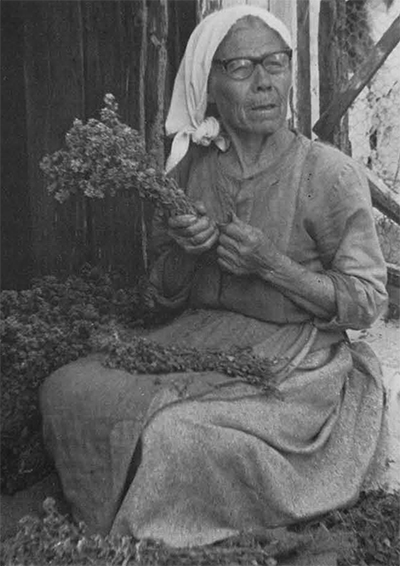
In addition to the evidence for game and fish, we can suggest that other resources supplemented the Franchthi diet in this pre-agricultural period. Limpets, we know, were collected. Sea urchins, periwinkles and octopuses could have been gathered easily at the shoreline, just as they are today. Shoreline cast-net fishing may have been practiced as well. Nets and other perishable string tools are very rarely preserved in the archaeological record to indicate their role in the prehistoric economy.
The rocky hillside around the cave probably provided the small animals, birds and snails found in the excavations. Reptiles, also present in the archaeological record, may have been eaten in the past even though none are eaten today. Insects and their worm-like larvae offer another potential food source.
Aristophanes and other ancient Greek writers mention the delicious nut-like appetizer of fried cicadas.
Wild olives, still preferred to domestic olives for eating on the island of Kerkyra in northwest Greece, were present in the later Palaeolithic and offer another likely resource. Ripe olives can easily be preserved by placing them in a basket or coarse cloth bag with a generous coating of salt, and a small population could have got all the salt it needed from pockets of sea water evaporated on rocks by the shore.
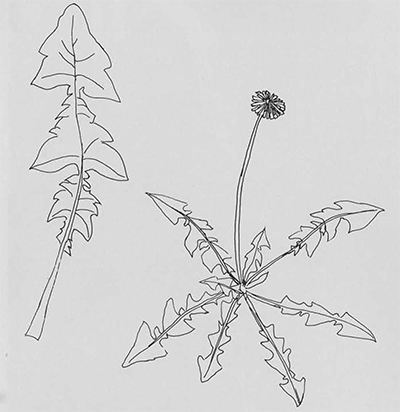
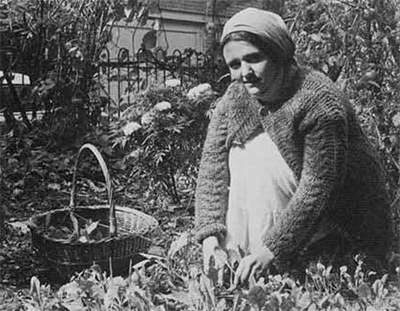
Seeds of lentil and vetch have been found in Palaeolithic levels, pistachio and almond nuts from the Mesolithic, and all but vetch are found again in the Neolithic period, after the beginning of plant cultivation. No doubt, grass seeds, mushrooms and wild fruit were collected in the more favorable, less rocky spots on the hillsides. Some of the larger game, grass seeds and other wild plant resources are likely to have been available in the Fournoi valley that runs inland to the north of the cave, and on the Koiladha plain to the south and east.
At the end of the list of potential resources for the Franchthi foragers is honey, a flavorful, high energy foodstuff much favored by modern hunters and gatherers in many parts of the world. The quality of Greek honey has been praised since Classical times. Also valuable is the beeswax saved by villagers today for church candles. The wax could have served a number of purposes in the tool kit of early man.
After the beginnings of agriculture and man’s interference with the natural vegetation in his cultivation of crops and grazing of livestock, a new class of plants that we term `weeds’ (or secondary domesticates) would have been available for exploitation for the leafy greens that play an important role in the modern farmer’s diet. As on Methane, the people living in the area of the Franchthi Cave gather a wide range of wild, leafy greens today. The marine and wild plant resources gathered in pre-farming days probably continued to play an important role in the diet of the Franchthi farmers.
We can detect wild plant use in the archaeological record only with great difficulty, mostly when chance preserves carbonized seeds and nuts. Pollen is not well preserved in the Franchthi Cave due to the alkaline character of the cave sediments and periodic wetting and drying. All of the wild plant resources used today are extremely perishable and highly unlikely to leave traces.
